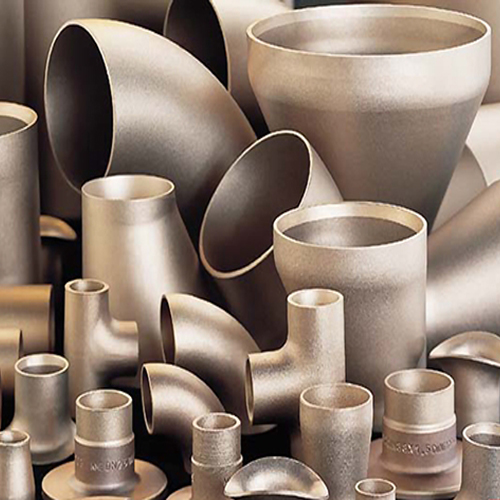Nickel pipe fittings typical application and advantages
Nickel Pipe Fittings Typical Application:
Nickel fittings have a wide range of applications across various industries. Some typical applications of nickel fittings include:
1. Plumbing and HVAC: Nickel fittings are commonly used in plumbing systems for connecting pipes, valves, and fixtures. They are also used in heating, ventilation, and air conditioning (HVAC) systems for joining different components.
2. Chemical processing: Nickel fittings are resistant to corrosion and high temperatures, making them suitable for use in chemical processing plants. They are used to connect pipes and equipment that handle corrosive and hazardous substances.
3. Oil and gas industry: Nickel fittings are utilized in the oil and gas industry for connecting pipelines and equipment. They can withstand harsh conditions, including high pressures and temperatures, making them ideal for offshore and onshore applications.
4. Power generation: Nickel fittings are commonly used in power plants, including nuclear, thermal, and renewable energy facilities. They are used to connect pipes and components in steam, water, and gas distribution systems.
5. Aerospace and defense: Nickel fittings are employed in aerospace and defense applications due to their strength and corrosion resistance. They are used in aircraft hydraulic systems, fuel lines, and other critical components.
6. Food and beverage industry: Nickel fittings are used in the food and beverage industry for sanitary applications. They are commonly found in processing plants, breweries, dairy facilities, and other food production environments.
There are several advantages of using nickel pipe fittings:
1. Corrosion resistance: Nickel is highly resistant to corrosion, making it an ideal choice for pipe fittings, especially in industries where the pipes are exposed to corrosive substances or environments.
2. High temperature resistance: Nickel has excellent heat resistance properties, allowing it to withstand high temperatures without deformation or deterioration. This makes nickel fittings suitable for applications that involve high-temperature fluids, such as in power plants and chemical industries.
3. Good mechanical properties: Nickel pipe fittings exhibit good strength, toughness, and ductility. This means they can withstand high-pressure and high-stress conditions without failure, ensuring the integrity and longevity of the piping system.
4. Compatibility: Nickel is compatible with a wide range of fluids and gases, including acids, alkalis, and hydrocarbons. This makes nickel pipe fittings versatile, suitable for various applications and industries.
5. Easy fabrication: Nickel is a malleable metal, which means it can be easily formed into various shapes and sizes during fabrication. This makes it easier to manufacture custom fittings for specific requirements.
6. Aesthetically pleasing: Nickel has a shiny, polished appearance that is aesthetically pleasing. It can enhance the visual appeal of piping systems, making them suitable for applications where appearance matters, such as architectural or decorative purposes.
Types of Nickel Pipe Fittings
Various types of nickel pipe fitting are used in piping, plumbing, and pipeline industries to serve as branch connections or other inline piping components. Common Pipe Fittings that are widely used in industries are listed below.
Nickel elbows: 90 Degrees bend long radius elbows, 90 degrees bending short radius elbows, 45 degrees bending elbows
Nickel tees: Nickel equal tee, nickel reducing tee
Nickel reducers: Nickel concentric reducers, nickel eccentric reducers
Nickel stub ends: long pattern nickel stub ends, short pattern nickel stub ends
Nickel pipe fittings produced in accordance with ASTM B366, dimension with ASME B16.9/ANSI B16.9
ASTM B366 specifies the American Society for Testing and Materials' (ASTM) specification for nickel and nickel-alloy pipe fittings.
-
Elbows: Nickel elbows can be used to change direction in a piping system. The elbows are available at different angles (e.g. 45 degrees or 90 degrees) in order to meet specific piping needs.
-
Nickel Tees are fittings which allow pipes to be split into two different directions. These fittings are T-shaped and used to distribute fluids and gases.
-
Reducers: Nickel-plated reducers can be used to join pipes with different diameters. They allow a smooth transition between a large pipe and a small one, or vice versa. Fluid flow is maintained while the pipe size changes.
-
Caps are used to seal off the ends of fittings or pipes. These caps provide a tight and leak-proof seal for pipes which are not being used or need to be temporarily closed.
-
Nickel Crosses are similar to tees, but they have an extra branch that allows for the creation of an intersection. These are used to connect multiple pipe lines at one point.
-
Nickel Stub Ends are used to join pipes with flanges. The pipe section is butt-welded on one end and flanged at the other.
-
Nickel couplings connect two pipes. These couplings are threaded, or socket-welded, and allow for an easy disassembly.
ASTM B366 specifies the dimensions, design, material characteristics, and testing requirements of these nickel fittings in order to ensure their performance and quality across various industries. These fittings are made from nickel alloys such as nickel-chromium alloys, nickel-copper alloys, and nickel molybdenum alloys, which offer excellent resistance against corrosion, heat, and pressure.
Latest News
Contact Us

Name: Mr. Ren
Tel: +86-18292471213
E-mail: info(at)intemetal.com
Add: Middle Section Baotai Road, Weibin District, 721013, Baoji, Shaanxi Province, China








